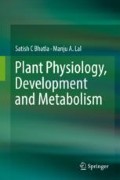Abstract
Both plants and animals go through onset and progress of certain processes leading to “aging” which ultimately causes death. Aging is defined as a degenerative biological change occurring over a period of time. Plants exhibit wide range of variations in life span, ranging from a week to few to many years. It is a common sight in temperate regions that the color of the leaves changes from green to yellow to orange or red before its final fall from the deciduous trees (Fig. 30.1). Such changes happen during the terminal phase of the life cycle of plants and are referred as senescence. Senescence is a self-digesting (autocatalytic) process controlled by environment and the genetic makeup of an organism. Changes taking place during this process are catabolic and thus irreversibly degenerative. Senescence is not just a passive decay of structural and biochemical machinery of cells; rather it is a precisely regulated series of events in which organelles, membranes, and macromolecules are broken down. Nutrients, like amino acids, sugars, and minerals, are reclaimed for export out of the senescing organ to other plant parts for later use. Nature is thus conservative as far as its precious resources are concerned. Another general term which is used for mechanisms underlying terminal events in the lives of a plant is programmed cell death (PCD). PCD is also a genetically determined developmental event which leads to elimination of a cell or cells. Such eliminations determine the final shape and habit of a plant. PCD occurs in a wide range of developmental processes. For example, development of unisexual flowers where cells destined to form male or female parts are selectively deleted (Fig. 30.2). Unlike PCD, senescence is a phase of aging process where metabolic processes are catabolic and eventually terminate in death.
Access this chapter
Tax calculation will be finalised at checkout
Purchases are for personal use only
Suggested Further Readings
Taiz L, Zeiger E (2010) Plant physiology, 5th edn. Sinauer Associates Inc, Sunderland, pp 665–692
Thomas H, Ougham H, Mur L, Jansson S (2015) Senescence and cell death. In: Buchanan BB, Gruissem W, Jones RL (eds) Biochemistry and molecular biology of plants. Wiley-Blackwell, Chichester, pp 925–982
Author information
Authors and Affiliations
Multiple-Choice Questions
Multiple-Choice Questions
-
1.
Catabolic process which is due to trauma caused by external agents and results in rupture of membranes and tissue inflammation:
-
(a)
Autophagy
-
(b)
Necrosis
-
(c)
Apoptosis
-
(d)
Degradation
-
(a)
-
2.
A highly regulated energy-dependent process leading to programmed cell death in animals:
-
(a)
Necrosis
-
(b)
Autophagy
-
(c)
Apoptosis
-
(d)
Senescence
-
(a)
-
3.
Which of the following cell organelle is degraded first during leaf senescence?
-
(a)
Peroxisomes
-
(b)
Mitochondria
-
(c)
Chloroplasts
-
(d)
Nuclei
-
(a)
-
4.
The mechanism used by plants to prevent spread of infection by killing the cells around infection site to prevent its further spread is called:
-
(a)
Hypersensitive response
-
(b)
Vacuolar response
-
(c)
Autophagy
-
(d)
Camouflage
-
(a)
Answers
1. b | 2. c | 3. c | 4. a |
Rights and permissions
Copyright information
© 2018 Springer Nature Singapore Pte Ltd.
About this chapter
Cite this chapter
Kalra, G., Bhatla, S.C. (2018). Senescence and Programmed Cell Death. In: Plant Physiology, Development and Metabolism. Springer, Singapore. https://doi.org/10.1007/978-981-13-2023-1_30
Download citation
DOI: https://doi.org/10.1007/978-981-13-2023-1_30
Published:
Publisher Name: Springer, Singapore
Print ISBN: 978-981-13-2022-4
Online ISBN: 978-981-13-2023-1
eBook Packages: Biomedical and Life SciencesBiomedical and Life Sciences (R0)

